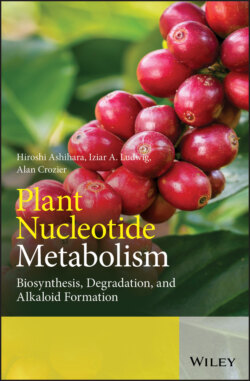Читать книгу Plant Nucleotide Metabolism - Hiroshi Ashihara - Страница 53
4.2 Reactions and Enzymes
ОглавлениеA summary of enzymes involved in purine nucleotide biosynthesis is presented in Table 4.1. Reaction steps, enzyme name, Enzyme Commission number (EC number), abbreviation of enzymes, gene names used in plants and E. coli, and TAIR locus are shown. The format of chromosomal-based nomenclature at TAIR is as follows: AT (A. thaliana) 1, 2, 3, 4, or 5 (chromosome number) or M for mitochondrial or C for chloroplast. G (gene), and five-digit code (numbered from top/north to bottom/south of chromosome).
The nomenclature of gene names in this field is not systematic, and considerable confusion exists in the genetic and biochemical literature. Although genes have often been called by the enzyme name, the genes of the de novo purine nucleotide synthesis are termed the pur genes. The bacterial genes are denoted by letters, e.g. purF for the step 1, but for ease of understanding, a numerical nomenclature proposed was by Smith and Atkins (2002) for plants, e.g. pur1, encodes the enzyme catalysing the first step of the pathway (Table 4.1). To distinguish genes from different plants the initials of species names are used as a prefix to the gene name, e.g. the pur1 gene from A. thaliana is designated Atpur1.
The de novo purine biosynthesis pathway occurs in cytosol of bacteria and animals. However, in plants there is speculation about the localization of the enzymes in plastids and mitochondria (Zrenner et al. 2006), although this possibility is not mentioned in the latest comprehensive plant biochemistry textbook (Buchanan et al. 2015). The activity of the enzymes involved in de novo purine biosynthesis is extremely low and, as a consequence, measurement of activity in plants is difficult, as is the determination of enzyme activity in fractionated organelles. Plastids and mitochondria isolated from nodules of cowpea using Percoll gradients are capable of IMP synthesis from ribose-5-phosphate or PRPP (Atkins et al. 1997). Thus, the complete capacity for de novo purine biosynthesis has been found in these organelles when isolated by effective fractionation procedures.
Protein subcellular localization predictions have been attempted. In general, most proteins in chloroplasts, plastids, and mitochondria are encoded by the nuclear genome and synthesized in the cytosol as high molecular weight precursors with N-terminal extensions called transit peptides. It has been reported that import of these proteins into chloroplasts requires the peptides and a translocon complex to be in the chloroplast envelope (Schleiff and Soll 2000). Most of the de novo purine biosynthesis enzymes appear to be located in chloroplasts, plastids, and mitochondria. The deficiency of 5-phosphoribosyl-1-pyrophosphate amidotransferase (PRAT) has a detrimental effect on chloroplast biogenesis (Hung et al. 2004). Berthome et al. (2008) reported that transient expression of a translational fusion with the green fluorescent protein in plantlets of A. thaliana showed that the protein of formylglycinamidine ribonucleotide (FGAM) synthase, the fourth enzyme of de novo purine biosynthesis, is dually targeted to chloroplasts and mitochondria. This indicates that at least some steps of the de novo purine biosynthesis pathway can take place in both organelles in A. thaliana, as well as in the ureide-forming tropical legumes. However, there are many difficulties in predicting the actual localization of the enzymes. For example, a number of proteins that have been identified are directed to plastids and mitochondria by the same targeting sequence (Chow et al. 1997; Menand et al. 1998).
Information in the literature on purine metabolism, especially de novo biosynthesis in plants, is fragmentary. However, it is possible to follow progress using databases linked to the TAIR gene locus numbers of A. thaliana as well as the EC numbers (the International Union of Biochemistry and Molecular Biology) shown in Table 4.1. Useful databases for nucleotide metabolism are KEGG (Kyoto Encyclopedia of Genes and Genomes), BRENDA (The Comprehensive Enzyme Information System), and MetaCyc (BioCyc Database Collection).
